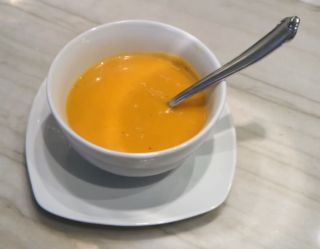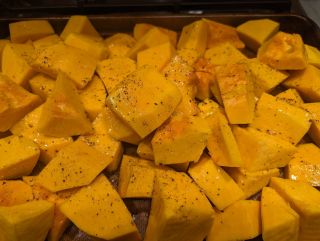Forgiveness
The Give in Forgiveness
Moving on with a cozy cup of Thanksgiving Roasted Butternut Squash Soup.
Posted November 19, 2023 Reviewed by Gary Drevitch
Key points
- Forgiveness is a personal decision to let something go and move on from it; to open a door for joy and relief.
- Our Thanksgiving Roasted Butternut Squash Soup is a welcoming appetizer whose spicy smell says cozy holiday.

Who do you want to forgive? And why do you want to forgive them? Was there an injustice done? Something that continues to have a grip on your being? Is it easy to hold on to that grudge, a now-familiar feeling that marks your emotional state when you think about that certain someone?
This Thanksgiving post invites us to reconsider that feeling we carry with us, and to think about other ways we might respond to it.
Forgiveness is the release of resentment or anger, a letting go of negative energy. It doesn’t necessarily mean reconciliation or forgetting, and it doesn't have to; the offender doesn't even need to know that you've moved on. You don't have to return to the same relationship or accept the same harmful behaviors from the offender.
Forgiveness is about a personal decision—a decision we make to let something go and move on from it. To shed something from our being that doesn’t sit well, opening up a door for new ingredients like joy, curiosity, and relief. And this release might make space for new ways to relate: room for new feelings and growing pockets of trust, including an increased sense of trust in ourselves.
Recently I re-connected with a dear friend from college. We grew up together, so to speak: figuring out the subjects we liked, thinking about life after college, learning to live on our own, making friends, going to parties, and falling for people.

Then we fell for the same person. In the end, it wasn’t me who moved forward with the relationship. We continued our friendship but it was different. I couldn’t hang out as much because it hurt and felt awkward. It was isolating. I missed her.
I cared about my dear friend but that sense of hurt lingered on my heart. It wasn’t about the love interest anymore. And I guess if things had gone the other way, she might’ve felt the same way I did.
In a recent visit, my friend brought up that time in conversation. She talked about how she’d asked if it was OK that she date the love interest, and that I had said yes, of course, it was important she follow her heart and do what she wanted to and what felt right. I’d forgotten that my dear friend had asked if her moving forward was OK with me.
As the conversation continued, my friend shared that she didn’t realize at that time how hurt I’d be. In part because it was isolating, I didn’t have my dear friend anymore, or the friends of the love interest, at least not in the way I used to.
All these years later, and I’m so grateful to have this friend back in my life in a way that feels like the way we used to connect. That conversation was freeing for me. It helped me remember the context of how things played out in the way that they did.
When we think about forgiveness, who are we giving for?
It might be in part for the other person, but it’s also for ourselves. It can be liberating to acknowledge something and let it go. To replace an internal tension with a new capacity for joy and love and, for me, a renewed friendship with deep historical meaning.
Our Thanksgiving Roasted Butternut Squash Soup is a welcoming, delicious appetizer for a Thanksgiving meal. Just the rich, spicy smell that fills the house when we cook it says cozy holiday.
This Thanksgiving as we stop and give thanks for what we have, perhaps we can also make a shift to support that open emotional space of loving possibility.
Who do you want to forgive?

Thanksgiving Roasted Butternut Squash Soup
(in our book, Eating Together Being Together, we just call it Roasted Butternut Squash Soup)
Ingredients
4 lb whole butternut squash (this equals about 2 medium squash)
4 Tbsp extra-virgin olive oil
1/3 cup maple syrup
1 Tbsp ground cinnamon, plus more for dusting
1 medium yellow onion, diced
4 cloves garlic, chopped
1/2 cup Greek yogurt
Fine sea salt and freshly ground black pepper
Serves 4.
Directions
Preheat the oven to 400°F.
Peel the butternut squash, remove the seeds, and cut into roughly 1-inch cubes. In a large bowl, toss the squash with 2 Tbsp olive oil and season it with salt and pepper. Spread the squash on a baking sheet and roast for 25 to 30 minutes, or until tender and lightly browned. Scrape the squash into a large bowl, add the maple syrup and cinnamon, and toss to fully coat the squash.
Meanwhile, warm the remaining 2 Tbsp of olive oil in a large saucepan over medium heat. Add the onion and garlic, season with salt and pepper, and cook, stirring occasionally, for about 5 minutes, or until soft. Add 5 cups of water and the squash and stir to incorporate. Raise the heat to medium-high and bring to a boil. Reduce the heat to medium-low and simmer, stirring occasionally and breaking up any large pieces of squash, for about 15 minutes. Remove from the heat.

All your soup won’t fit in your blender at once, so please hear this really important point: Only fill your blender halfway and then place the lid on top. Next, cover the lid with a dry towel and hold it down with your hand. This is important for safety because sometimes the force of the engaging blades will push your hot soup to the top of the bowl and it might escape, resulting in painful burns. With these safety measures, you can use your blender to purée the soup in batches until it’s smooth. Alternatively, use an immersion blender (a blender on a stick), once again being careful of the hot liquid. If the soup is too thick, add a little water. Experiment with seasoning as you figure out how much salt and pepper are needed.
Portion out the soup into four warm bowls. It’s fun to add the finishing touches by floating some Greek yogurt in the soup and sprinkling a little ground cinnamon on top.
Sip, be cozy, and let go!
References
Clauss-Ehlers, J.C.E., & Clauss-Ehlers, C.S. 92022). Eating together being together: Recipes, activities, and advice from a chef dad and psychologist mom. Princeton Architectural Press.
Mayo Clinic Staff (n.d.). Forgiveness: Letting go of grudges and bitterness. https://www.mayoclinic.org/healthy-lifestyle/adult-health/in-depth/forg…




